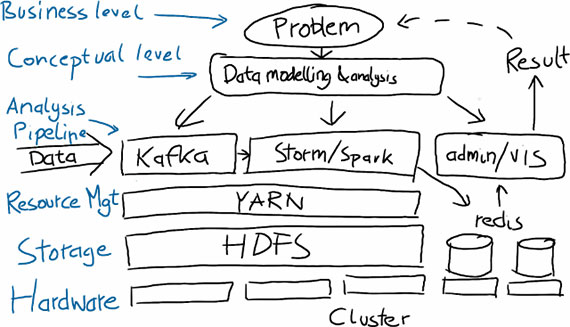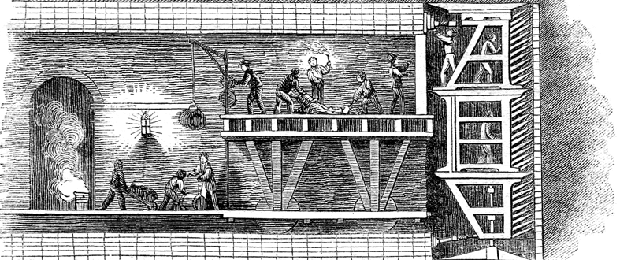"O’Reilly Data Show Podcast" entries

6 reasons why I like KeystoneML
The O'Reilly Data Show Podcast: Ben Recht on optimization, compressed sensing, and large-scale machine learning pipelines.
As we put the finishing touches on what promises to be another outstanding Hardcore Data Science Day at Strata + Hadoop World in New York, I sat down with my co-organizer Ben Recht for the the latest episode of the O’Reilly Data Show Podcast. Recht is a UC Berkeley faculty member and member of AMPLab, and his research spans many areas of interest to data scientists including optimization, compressed sensing, statistics, and machine learning.
At the 2014 Strata + Hadoop World in NYC, Recht gave an overview of a nascent AMPLab research initiative into machine learning pipelines. The research team behind the project recently released an alpha version of a new software framework called KeystoneML, which gives developers a chance to test out some of the ideas that Recht outlined in his talk last year. We devoted a portion of this Data Show episode to machine learning pipelines in general, and a discussion of KeystoneML in particular.
Since its release in May, I’ve had a chance to play around with KeystoneML and while it’s quite new, there are several things I already like about it:
KeystoneML opens up new data types
Most data scientists don’t normally play around with images or audio files. KeystoneML ships with easy to use sample pipelines for computer vision and speech. As more data loaders get created, KeystoneML will enable data scientists to leverage many more new data types and tackle new problems. Read more…

Why data preparation frameworks rely on human-in-the-loop systems
The O'Reilly Data Show Podcast: Ihab Ilyas on building data wrangling and data enrichment tools in academia and industry.
As I’ve written in previous posts, data preparation and data enrichment are exciting areas for entrepreneurs, investors, and researchers. Startups like Trifacta, Tamr, Paxata, Alteryx, and CrowdFlower continue to innovate and attract enterprise customers. I’ve also noticed that companies — that don’t specialize in these areas — are increasingly eager to highlight data preparation capabilities in their products and services.
During a recent episode of the O’Reilly Data Show Podcast, I spoke with Ihab Ilyas, professor at the University of Waterloo and co-founder of Tamr. We discussed how he started working on data cleaning tools, academic database research, and training computer science students for positions in industry.
Academic database research in data preparation
Given the importance of data integrity, it’s no surprise that the database research community has long been interested in data preparation and data wrangling. Ilyas explained how his work in probabilistic databases led to research projects in data cleaning:
In the database theory community, these problems of handling, dealing with data inconsistency, and consistent query answering have been a celebrated area of research. However, it has been also difficult to communicate these results to industry. And database practitioners, if you like, they were more into the well-structured data and assuming a lot of good properties around this data, [and they were also] more interested in indexing this data, storing it, moving it from one place to another. And now, dealing with this large amount of diverse heterogeneous data with tons of errors, sidled across all business units in the same enterprise became a necessity. You cannot really avoid that anymore. And that triggered a new line of research for pragmatic ways of doing data cleaning and integration. … The acquisition layer in that stack has to deal with large sets of formats and sources. And you will hear about things like adapters and source adapters. And it became a market on its own, how to get access and tap into these sources, because these are kind of the long tail of data.
…
The way I came into this subject was also funny because we were talking about the subject called probabilistic databases and how to deal with data uncertainty. And that morphed into trying to find data sets that have uncertainty. And then we were shocked by how dirty the data is and how data cleaning is a task that’s worth looking at.

Building self-service tools to monitor high-volume time-series data
The O'Reilly Data Show Podcast: Phil Liu on the evolution of metric monitoring tools and cloud computing.
One of the main sources of real-time data processing tools is IT operations. In fact, a previous post I wrote on the re-emergence of real-time, was to a large extent prompted by my discussions with engineers and entrepreneurs building monitoring tools for IT operations. In many ways, data centers are perfect laboratories in that they are controlled environments managed by teams willing to instrument devices and software, and monitor fine-grain metrics.
During a recent episode of the O’Reilly Data Show Podcast, I caught up with Phil Liu, co-founder and CTO of SignalFx, a SF Bay Area startup focused on building self-service monitoring tools for time series. We discussed hiring and building teams in the age of cloud computing, building tools for monitoring large numbers of time series, and lessons he’s learned from managing teams at leading technology companies.
Evolution of monitoring tools
Having worked at LoudCloud, Opsware, and Facebook, Liu has seen first hand the evolution of real-time monitoring tools and platforms. Liu described how he has watched the number of metrics grow, to volumes that require large compute clusters:
One of the first services I worked on at LoudCloud was a service called MyLoudCloud. Essentially that was a monitoring portal for all LoudCloud customers. At the time, [the way] we thought about monitoring was still in a per-instance-oriented monitoring system. [Later], I was one of the first engineers on the operational side of Facebook and eventually became part of the infrastructure team at Facebook. When I joined, Facebook basically was using a collection of open source software for monitoring and configuration, so these are things that everybody knows — Nagios, Ganglia. It started out basically using just per-instance instant monitoring techniques, basically the same techniques that we used back at LoudCloud, but interestingly and very quickly as Facebook grew, this per-instance-oriented monitoring no longer worked because we went from tens or thousands of servers to hundreds of thousands of servers, from tens of services to hundreds and thousands of services internally.

Apache Spark: Powering applications on-premise and in the cloud
The O'Reilly Data Show Podcast: Patrick Wendell on the state of the Spark ecosystem.
As organizations shift their focus toward building analytic applications, many are relying on components from the Apache Spark ecosystem. I began pointing this out in advance of the first Spark Summit in 2013 and since then, Spark adoption has exploded.
With Spark Summit SF right around the corner, I recently sat down with Patrick Wendell, release manager of Apache Spark and co-founder of Databricks, for this episode of the O’Reilly Data Show Podcast. (Full disclosure: I’m an advisor to Databricks). We talked about how he came to join the UC Berkeley AMPLab, the current state of Spark ecosystem components, Spark’s future roadmap, and interesting applications built on top of Spark.
User-driven from inception
From the beginning, Spark struck me as different from other academic research projects (many of which “wither away” when grad students leave). The AMPLab team behind Spark spoke at local SF Bay Area meetups, they hosted 2-day events (AMP Camp), and worked hard to help early users. That mindset continues to this day. Wendell explained:
We were trying to work with the early users of Spark, getting feedback on what issues it had and what types of problems they were trying to solve with Spark, and then use that to influence the roadmap. It was definitely a more informal process, but from the very beginning, we were expressly user-driven in the way we thought about building Spark, which is quite different than a lot of other open source projects. We never really built it for our own use — it was not like we were at a company solving a problem and then we decided, “hey let’s let other people use this code for free”. … From the beginning, we were focused on empowering other people and building platforms for other developers, so I always thought that was quite unique about Spark.

Data science makes an impact on Wall Street
The O'Reilly Data Show Podcast: Gary Kazantsev on how big data and data science are making a difference in finance.
Learn more about Next:Money, O’Reilly’s conference focused on the fundamental transformation taking place in the finance industry.
 Having started my career in industry, working on problems in finance, I’ve always appreciated how challenging it is to build consistently profitable systems in this extremely competitive domain. When I served as quant at a hedge fund in the late 1990s and early 2000s, I worked primarily with price data (time-series). I quickly found that it was difficult to find and sustain profitable trading strategies that leveraged data sources that everyone else in the industry examined exhaustively. In the early-to-mid 2000s the hedge fund industry began incorporating many more data sources, and today you’re likely to find many finance industry professionals at big data and data science events like Strata + Hadoop World.
Having started my career in industry, working on problems in finance, I’ve always appreciated how challenging it is to build consistently profitable systems in this extremely competitive domain. When I served as quant at a hedge fund in the late 1990s and early 2000s, I worked primarily with price data (time-series). I quickly found that it was difficult to find and sustain profitable trading strategies that leveraged data sources that everyone else in the industry examined exhaustively. In the early-to-mid 2000s the hedge fund industry began incorporating many more data sources, and today you’re likely to find many finance industry professionals at big data and data science events like Strata + Hadoop World.
During the latest episode of the O’Reilly Data Show Podcast, I had a great conversation with one of the leading data scientists in finance: Gary Kazantsev runs the R&D Machine Learning group at Bloomberg LP. As a former quant, I wanted to know the types of problems Kazantsev and his group work on, and the tools and techniques they’ve found useful. We also talked about data science, data engineering, and recruiting data professionals for Wall Street. Read more…

The tensor renaissance in data science
The O'Reilly Data Show Podcast: Anima Anandkumar on tensor decomposition techniques for machine learning.
After sitting in on UC Irvine Professor Anima Anandkumar’s Strata + Hadoop World 2015 in San Jose presentation, I wrote a post urging the data community to build tensor decomposition libraries for data science. The feedback I’ve gotten from readers has been extremely positive. During the latest episode of the O’Reilly Data Show Podcast, I sat down with Anandkumar to talk about tensor decomposition, machine learning, and the data science program at UC Irvine.
Modeling higher-order relationships
The natural question is: why use tensors when (large) matrices can already be challenging to work with? Proponents are quick to point out that tensors can model more complex relationships. Anandkumar explains:
Tensors are higher order generalizations of matrices. While matrices are two-dimensional arrays consisting of rows and columns, tensors are now multi-dimensional arrays. … For instance, you can picture tensors as a three-dimensional cube. In fact, I have here on my desk a Rubik’s Cube, and sometimes I use it to get a better understanding when I think about tensors. … One of the biggest use of tensors is for representing higher order relationships. … If you want to only represent pair-wise relationships, say co-occurrence of every pair of words in a set of documents, then a matrix suffices. On the other hand, if you want to learn the probability of a range of triplets of words, then we need a tensor to record such relationships. These kinds of higher order relationships are not only important for text, but also, say, for social network analysis. You want to learn not only about who is immediate friends with whom, but, say, who is friends of friends of friends of someone, and so on. Tensors, as a whole, can represent much richer data structures than matrices.

Coming full circle with Bigtable and HBase
The O'Reilly Data Show Podcast: Michael Stack on HBase past, present, and future.
Subscribe to the O’Reilly Data Show to explore the opportunities and techniques driving big data and data science.
At least once a year, I sit down with Michael Stack, engineer at Cloudera, to get an update on Apache HBase and the annual user conference, HBasecon. Stack has a great perspective, as he has been part of HBase since its inception. As former project leader, he remains a key contributor and evangelist, and one of the organizers of HBasecon.
In the beginning: Search and Bigtable
During the latest episode of the O’Reilly Data Show Podcast, I decided to broaden our conversation to include the beginnings of the very popular Apache HBase project. Stack reminded me that in the early days much of the big data community in the SF Bay Area was centered around search technologies, such as HBase. In particular, HBase was inspired by work out of Google (Bigtable), and the early engineers had ties to projects out of the Internet Archive:
At the time, I was working at the Internet Archive, and I was working on crawlers and search. The Bigtable paper looked really interesting to us because the archive, as you know, we used to host — or still do — the Wayback Machine. The Wayback Machine is a picture of the Web that goes back to 1998, and you could look at the Web at any particular time. What pages looked liked at a particular time. Bigtable was very interesting at the Internet Archive because it had this time dimension.
…
A group had started up to talk about the possibility of implementing a Bigtable clone. It was centered at a place called Powerset, a startup that was in San Francisco back then. That was about doing a search, so I went and talked to them. They said, ‘Come on over and we’ll make a space for doing a Bigtable clone.’ They had a very intricate search pipeline, and it was based on early Amazon AWS, and every time they started up their pipeline, they’d get a phone call from Amazon saying, ‘Please stop whatever it is you’re doing.’ … The first engineer would be a fellow called Jim Kellerman. The actual first 30 classes came from Mike Cafarella. He was instrumental in getting the first versions of Hadoop going. He was hanging around Apache Nutch at the time. … Doug [Cutting] used to work at the Internet archive, and the first actual versions of Hadoop were run on racks at the Internet archive. Doug was working on fulltext search. Then he moved on to go to Yahoo, to work on Hadoop full time.

Building big data systems in academia and industry
The O'Reilly Data Show Podcast: Mikio Braun on stream processing, academic research, and training.
Mikio Braun is a machine learning researcher who also enjoys software engineering. We first met when he co-founded a real-time analytics company called streamdrill. Since then, I’ve always had great conversations with him on many topics in the data space. He gave one of the best-attended sessions at Strata + Hadoop World in Barcelona last year on some of his work at streamdrill.
I recently sat down with Braun for the latest episode of the O’Reilly Data Show Podcast, and we talked about machine learning, stream processing and analytics, his recent foray into data science training, and academia versus industry (his interests are a bit on the “applied” side, but he enjoys both).

An example of a big data solution. Source: Mikio Braun, used with permission.

Redefining power distribution using big data
The O'Reilly Data Show Podcast: Erich Nachbar on testing and deploying open source, distributed computing components.
 When I first hear of a new open source project that might help me solve a problem, the first thing I do is ask around to see if any of my friends have tested it. Sometimes, however, the early descriptions sound so promising that I just jump right in and try it myself — and in a few cases, I transition immediately (this was certainly the case for Spark).
When I first hear of a new open source project that might help me solve a problem, the first thing I do is ask around to see if any of my friends have tested it. Sometimes, however, the early descriptions sound so promising that I just jump right in and try it myself — and in a few cases, I transition immediately (this was certainly the case for Spark).
I recently had a conversation with Erich Nachbar, founder and CTO of Virtual Power Systems, and one of the earliest adopters of Spark. In the early days of Spark, Nachbar was CTO of Quantifind, a startup often cited by the creators of Spark as one of the first “production deployments.” On the latest episode of the O’Reilly Data Show Podcast, we talk about the ease with which Nachbar integrates new open source components into existing infrastructure, his contributions to Mesos, and his new “software-defined power distribution” startup.
Ecosystem of open source big data technologies
When evaluating a new software component, nothing beats testing it against workloads that mimic your own. Nachbar has had the luxury of working in organizations where introducing new components isn’t subject to multiple levels of decision-making. But, as he notes, everything starts with testing things for yourself:
“I have sort of my mini test suite…If it’s a data store, I would just essentially hook it up to something that’s readily available, some feed like a Twitter fire hose, and then just let it be bombarded with data, and by now, it’s my simple benchmark to know what is acceptable and what isn’t for the machine…I think if more people, instead of reading papers and paying people to tell them how good or bad things are, would actually set aside a day and try it, I think they would learn a lot more about the system than just reading about it and theorizing about the system. Read more…

Turning Ph.D.s into industrial data scientists and data engineers
The O'Reilly Data Show Podcast: Angie Ma on building a finishing school for science and engineering doctorates.
Editor’s note: The ASI will offer a two-day intensive course, Practical Machine Learning, at Strata + Hadoop World in London in May.
Back when I was considering leaving academia, the popular exit route was financial engineering. Many science and engineering Ph.D.s ended up in big Wall Street banks; I chose to be the lead quant at a small hedge fund — it was a natural choice for many of us. Financial engineering was topically close to my academic interests, and working with traders meant access to resources and interesting problems.
Today, there are many more options for people with science and engineering doctorates. A few organizations take science and engineering Ph.D.s, and over the course of 8-12 weeks, prepare them to join the ranks of industrial data scientists and data engineers.
I recently sat down with Angie Ma, co-founder and president of ASI, a London startup that runs a carefully structured “finishing school” for science and engineering doctorates. We talked about how Angie and her co-founders (all ex-physicists) arrived at the concept of the ASI, the structure of their training programs, and the data and startup scene in the UK. [Full disclosure: I’m an advisor to the ASI.] Read more…





